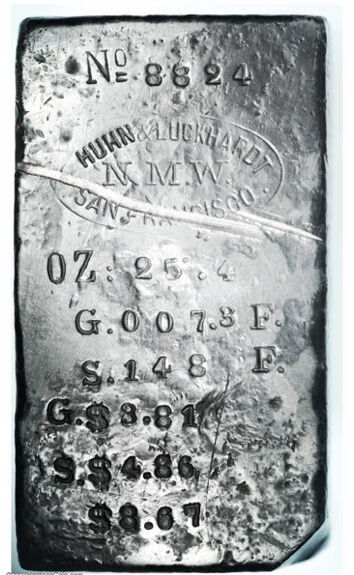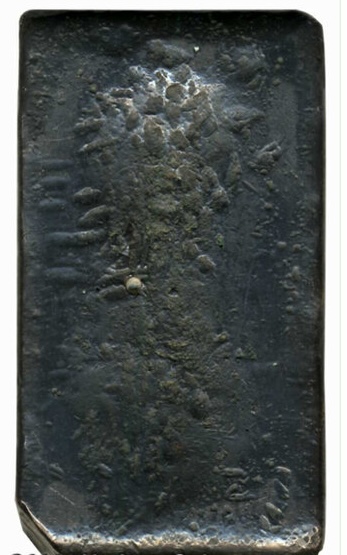25.4 oz Huhn & Luckhardt “Base Bar.”


This unusual item was found with a metal detector in Waco, Texas on the site of an old building that was being torn down. We have never seen anything quite like it, and frankly, were challenged to find out just what it is.
According to the Ninth Annual Report of the State Mineralogist for the year ending December 1, 1889, by the California State Mining Bureau, base bars “contain a large percentage of base alloys, usually comprising lead and antimony, or copper, differing in their contents in silver from one hundred to six hundred in one thousand, and often containing gold.”
This particular bar is primarily copper, as one can see from the deep scratch across the face. However, it is also 14% silver with just a trace of gold present. We had the bar tested at Metallurgical Engineering Services (in Richardson) and their report bears out the assay stamped on the top of the bar. They performed two Energy Dispersive X-Ray Spectroscopy analyses, one of the blackened bar and the other of the scratched area. The blackened surface shows 62.39% copper, 15.08% silver, and 0.74% gold. The scratched area shows slightly different numbers with 82.13% copper (the difference being the presence of carbon, oxygen, chlorine, and iron on the blackened surface that is not found within the scratch), 15.89% silver, and 0.64% gold.
Our understanding of a base bar is it is the naturally occurring ore put into bar form for transportation purposes. In other words, it is an intermediate step between the metal as it is pulled from the mine and a finished, high fineness bar. This particular bar has the following stampings on the face: No 8824 / HUHN & LUCKHARDT / N.M.W. / SAN FRANCISCO / OZ: 25.4 / G. 007.3 F. / S. 148 F. / G. $3.81 / S. $4.86 / $8.67. Two assay chips were taken out of two of the corners of the bar.
The consignor was quite fascinated by this find and did a considerable amount of research. He discovered the N.M.W. reference in the company logo refers to Nevada Metallurgical Works, a company listed in an ad in the Salt Lake City directory in 1873 and listing C.A. Luckhardt as one of the principals. Luckhardt was also listed in a special edition of the San Francisco Call “Days of ’49. The Days of ’92” from January 3, 1892. He was listed as a mining engineer-chemist, born in Germany. However, no mention was made of a land swindle Luckhardt was involved in back in 1881 where he gave “worthless property an exotic stage name, added to the board some respected individuals not previously associated with mining scams, and promoted the property until it became the speculative favorite of Broadway. The price went from $1 par to over $14. They made millions at the expense of unsuspecting market players and investors.” Luckhardt’s name appears again in the 1903 San Francisco phone directory, listed as an assayer and located at 71 Stevenson. In that same directory, Nevada Metallurgical Works was also listed at 71 Stevenson, and both are listed with the same phone number, Main 5104.
The bar itself is blackened but not corroded. Apparently it was packed so tightly in the earth for a hundred years or so that very little oxygen was present and could not react with the surface to corrode it. There are numerous signs of handling, small nicks and bumps, but the only detracting flaw is the above-mentioned angling scratch, which was presumably done at the time it was unearthed.
It is very likely that this base bar is the only tangible remnant from this little-known California assayer.
Huhn & Luckhardt Copper-Silver-Gold Ingot Found in Waco, Texas. The presence of this ingot in Waco, Texas represents a significant anomaly. It may be composed of metals mined near Van Horn, Texas in the Trans-Pecos region near the border of Texas and New Mexico about 75 miles west-southwest of Pecos, Texas during the modern discovery period, about 1880.
Caesar A. Luckhardt had worked as a partner in the assaying and mining consulting firm of Riotte & Luckhardt in San Francisco since its formation about 1871. Eugene Riotte sold his interest in the firm to Ernest Huhn about 1875, and added the name “Nevada Metallurgical Works.” Advertisements for Huhn & Luckhardt promoted their services as consulting mining engineers, metallurgists, and assayers. The pair advertised prolifically in the Mining & Scientific Press, and in both Langley’s and Bishop’s San Francisco Directories.
Huhn retired from the firm about 1880, and his name was dropped from advertisements and directory listings. Luckardt & Co. continued the operation of the Nevada Metallurgical Works until Luckhardt’s retirement about 1907. Luckhardt and partners were the longest lasting assaying and mining consulting firm in San Francisco at the time, lasting at least 36 years.
Copper-silver ores have been known in west Texas since historic times. About 1880, prospects near Van Horn, Texas were examined and the Hazel Mine and nearby properties were developed, with the first production reported in 1886. The deposit was cited as “argentiferous copper ore in a fissure vein with bornite and erubescite,” according to David Day in his Mineral Resources of the United States for the Calendar Year 1887, published by the Government Printing Office in 1888. Within four years several mines in west Texas, including the Hazel mine and another near Shafter, located about 100 miles south of Pecos, were producing about $300,000-$400,000 in silver per year, according to Rothwell, Editor of the Mineral Industry for the Year 1892, published by the American Institute of Mining Engineers as a statistical supplement to the Engineering and Mining Journal.
Precious metals mining in Texas in the early years is not well documented. Located more centrally in the United States, Texas was not heavily prospected. The majority of activity was in or near states where significant quantities of gold were found, something relatively easy to find in trace amounts by panning stream channels. Silver, however, is more difficult to locate if not associated with larger quantities of gold. Since little gold was found in Texas, prospectors went elsewhere. Meanwhile, reporting of prospecting also was centered around geographic areas in America known for their precious metal deposits. Texas wasn’t one of them, so the state’s prospecting activities were off the radar for the two standard mining industry journals of the 1880 period, the Mining and Scientific Press and the Engineering and Mining Journal.
The Huhn & Luckhardt copper-silver ingot is a significant discovery because it may represent some of the first precious metal ores mines by Americans in Texas. As a copper-silver ingot, it is an anomaly. It represents a dore ingot containing metals from the original ore deposit in their approximate original compositional amounts. Few such ingots survive today, mostly because most dore ingots contain greater amounts of gold and silver. Copper, if present, was often removed in the melting process using a flux. It would only have been left behind in the ingot when used to represent the natural metals contained in ores from specific ore deposits, then publicly exhibited to promote the mine or a mining company. Exhibits of this nature were commonplace at the time, particularly in association with national or international fairs or exhibitions. The relative proportions of copper, silver, and gold in this ingot are very close to those found in the Van Horn District at and near the Hazel mine, as reported in industry journals of the period. This is an unusual match, not duplicated in any of the California ingots studied by the author (Fred Holabird) over the past twenty years. It is in this capacity that the ingot may have been used in Waco, to promote the mine or company. Huhn & Luckhardt were professional mining consultants, possibly hired to evaluate some of the small mines near Van Horn. They could easily have poured a copper-silver-gold dore ingot from their work on Van Horn ores and presented the same to company officials.
This unusual item was found with a metal detector in Waco, Texas on the site of an old building that was being torn down. According to the Ninth Annual Report of the State Mineralogist for the year ending December 1, 1889, by the California State Mining Bureau, base bars “contain a large percentage of base alloys, usually comprising lead and antimony, or copper, differing in their contents in silver from one hundred to six hundred in one thousand, and often containing gold.” This particular bar is primarily copper, as one can see from the deep scratch across the face. However, it is also 14% silver with just a trace of gold present. This bar was tested almost two years ago by Metallurgical Engineering Services (in Richardson) and the report they issued (since separated from the ingot) at that time bears out the assay stamped on the top of the bar. They performed two Energy Dispersive X-Ray Spectroscopy analyses, one of the blackened bar and the other of the scratched area. The blackened surface shows 62.39% copper, 15.08% silver, and 0.74% gold. The scratched area shows slightly different numbers with 82.13% copper (the difference being the presence of carbon, oxygen, chlorine, and iron on the blackened surface that is not found within the scratch), 15.89% silver, and 0.64% gold.
A base bar is the naturally occurring ore put into bar form for transportation purposes. In other words, it is an intermediate step between the metal as it is pulled from the mine and a finished, high fineness bar. This particular bar has the following stampings on the face: No 8824 / HUHN & LUCKHARDT / N.M.W. / SAN FRANCISCO / OZ: 25.4 / G. 007.3 F. / S. 148 F. / G. $3.81 / S. $4.86 / $8.67. Two assay chips were taken out of two of the corners of the bar.
The original owner and finder of this bar was quite fascinated by this find and did a considerable amount of background research. In addition to the findings above by Fred Holabird, the original owner found that N.M.W. reference in the company logo refers to Nevada Metallurgical Works, a company listed in an ad in the Salt Lake City directory in 1873 and listing C.A. Luckhardt as one of the principals. Luckhardt was also listed in a special edition of the San Francisco Call “Days of ’49, The Days of ’92” from January 3, 1892. He was listed as a mining engineer-chemist, born in Germany. However, no mention was made of a land swindle Luckhardt was involved in back in 1881 where he gave “worthless property an exotic stage name, added to the board some respected individuals not previously associated with mining scams, and promoted the property until it became the speculative favorite of Broadway. The price went from $1 par to over $14. They made millions at the expense of unsuspecting market players and investors.” Luckhardt’s name appears again in the 1903 San Francisco phone directory, listed as an assayer and located at 71 Stevenson. In that same directory, Nevada Metallurgical Works was also listed at 71 Stevenson, and both are listed with the same phone number, Main 5104.
The bar itself is blackened but not corroded. Apparently it was packed so tightly in the earth for a hundred years or so that very little oxygen was present and could not react with the surface to corrode it. There are numerous signs of handling, small nicks and bumps, but the only detracting flaw is the above-mentioned angling scratch, which was presumably done at the time it was unearthed.
It is very likely that this base bar is the only tangible remnant from this little-known California assayer.
From The Alan Bingel Collection, Part Two.
[08/2005] https://www.icollector.com/Huhn-Luckhardt-Copper-Silver-Gold-Ingot-Found-i_i5251933 ($28,800)
